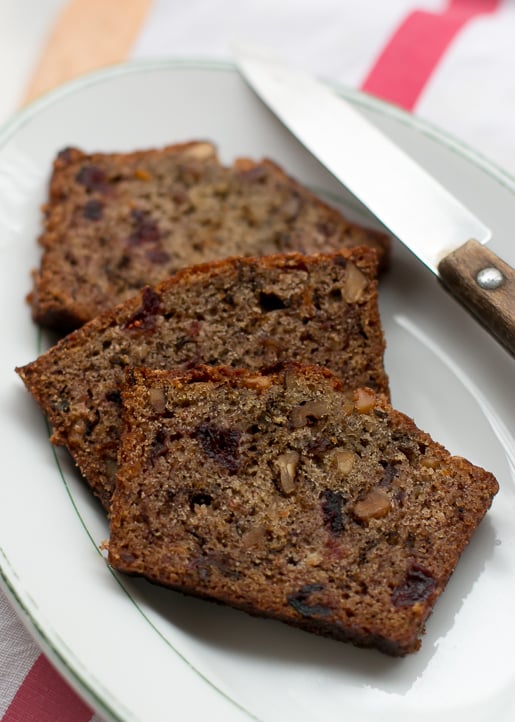James Beard’s Amazing Persimmon Bread Recipe

Like most Americans, even French people aren’t so familiar with persimmons. They may see them at the market, look at their curiously, but don’t stop to buy any. Or if they do, they take them home, bite into an unripe one, make a face, and toss them out.
One of my friends living north of San Francisco in Sonoma County had an enormous persimmon tree. Each fall, the leaves would drift off the tree, leaving bright orange globes of fruit dangling off the sparse branches. The beautiful, gnarled wood was quite a contrast to the smooth, brilliantly-colored orbs of fruit. (The wood of the persimmon tree is not just beautiful but it’s prized by makers of many of the finest golf clubs in the world and is considered superior to most others woods or man-made materials.)
The most common persimmon you’re likely to find is the Hachiya, a slightly elongated fruit that tapers to a point. They’re incredibly tannic and astringent when not ripe and need to be squishy-soft and feel like a full water-balloon before using. Once ripe, the sweet jelly-like pulp can be spooned out and pureed through a blender, food processor, or food mill, although some folks like to eat it as is or frozen. The pulp freezes beautifully, and in fact, I’ll often freeze some for late-winter use. To ripen Hachiya persimmons, simply let them sit on your countertop until very soft. If they don’t riped at the same time, you can store the puree in the refrigerator until the others have ripened. You can hasten the process by putting persimmons in a well-sealed container; adding an apple, which gives off a lot of ethylene gas, which will speed things up.
The other common persimmon is the Fuyu, which is squatter than the Hachiya and matte-orange. Unlike the Hachiya, the Fuyu is meant to be eaten hard and is delightfully crunchy. I peel them, then mix pieces into an autumnal fruit salad along with dates, slices of Comice pears, pomegranate seeds and yes…even some bits of prunes. Finding recipes for using persimmons can be difficult. I invented a recipe for a quick Persimmon Cake for my book Room For Dessert, which I make often for Thanksgiving. And I also like James Beard’s Persimmon Bread, a nifty recipe from his classic book on breadmaking, Beard on Bread, published over 30 years ago.
I was fortunate to meet James Beard several times when he came to dinner at Chez Panisse. In the years after he passed away, we’d get all sorts of luminaries coming through our kitchen, people like James Beard, Jane Grigson, and Richard Olney, who were really wonderful cooks and writers.
The most charming thing about this simple Persimmon Bread recipe is that Beard gives bakers an inexact amount of an ingredient: sugar. So go ahead just this one time to improvise a little. Although I recommend using the higher amount of sugar, feel free to use whichever quantity you’d like…after all, you have permission from the granddaddy of all cooks, James Beard himself.
Persimmon Bread
- 3 1/2 cups sifted flour
- 1 1/2 teaspoons salt
- 2 teaspoon baking soda
- 1 teaspoon ground nutmeg
- 2 to 2 1/2 cups (400-500g) sugar
- 1 cup (8oz, 225g) melted unsalted butter and cooled to room temperature
- 4 large eggs, at room temperature, lightly beaten
- 2/3 cup (160ml) Cognac or bourbon whiskey (see headnote)
- 2 cups (500ml) persimmon puree, (from about 4 squishy-soft Hachiya persimmons)
- 2 cups (200g) walnuts or pecans, toasted and chopped
- 2 cups (270g) raisins, or diced dried fruits (such as apricots, cranberries, or dates)
- Butter 2 loaf pans. Line the bottoms with a piece of parchment paper or dust with flour and tap out any excess.
- Preheat oven to 350ºF (180ºC) degrees.
- Sift the first 5 dry ingredients in a large mixing bowl.
- Make a well in the center then stir in the butter, eggs, liquor, persimmon puree then the nuts and raisins.
- Bake 1 hour or until toothpick inserted into the center comes out clean.






















